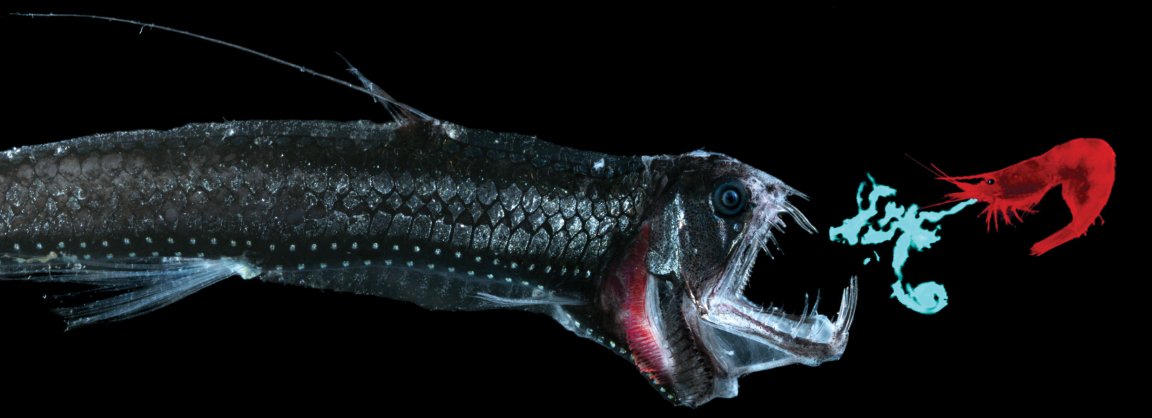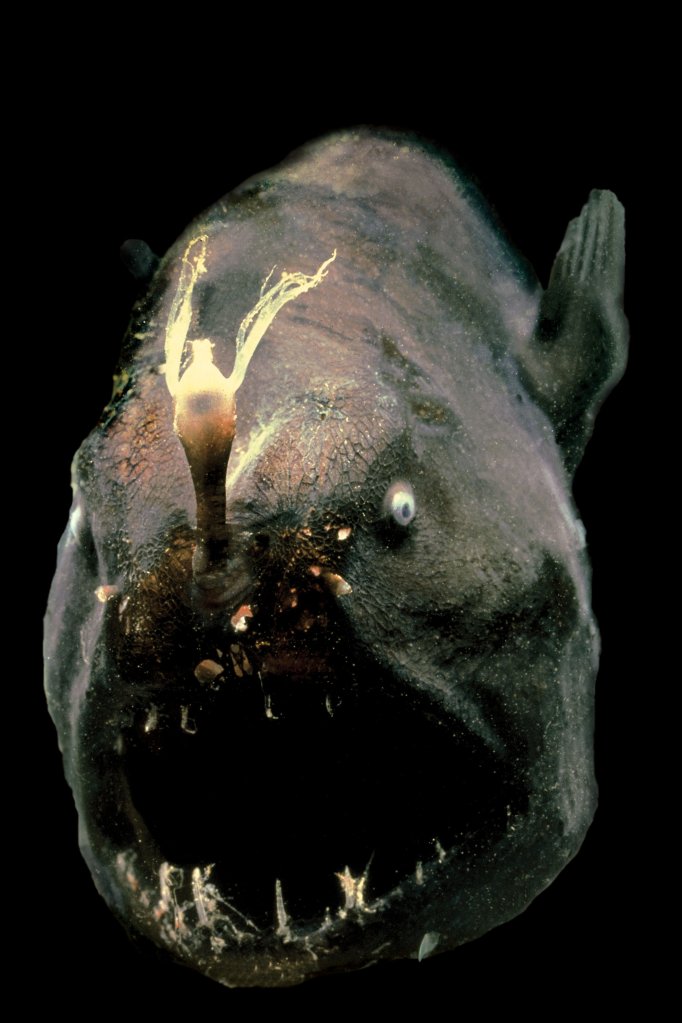
There are a number of amazing creatures in the depths of Earth’s oceans. Here are some of our favorites….
1. The Viperfish

This horror of the deep is the viperfish. In the above image, taken by Edith Widder, the fish appears to be attacking a small shrimp, which is using its bioluminescent spray in an attempt to distract the viperfish. As you can see, the fangs on this monstrosity are so large that they will not fit properly inside the fish’s mouth. Instead, the teeth curve back, coming alarmingly close to the fish’s eyes. The viperfish is thought to use these sharp teeth to impale its victims by swimming at them at high speeds.
Fortunately, the fish is a bit on the smallish side, measuring just 12 inches (30 centimeters) in length.
The big, pole-like arch coming from the back of the viperfish is actually a small light that is used to attract prey. The viperfish hunts in near total darkness, so it uses its elongated dorsal fin ray like a lure. They are often found at depths reaching 5,000 feet (1,500 meters). However, they have been found at depths exceeding 9,100 feet (2,800 meters). So at least we won’t have to worry about stepping on one of these little guys during a nice stroll on the beach.
2) The Anglerfish

Normally found about a mile under the surface, the female anglerfish has what looks like a fishing rod protruding above its mouth. This accessory, much like the viperfish’s previously mentioned device, is an elongated dorsal spine. It is this spine-light that lures prey to the creature’s hideous crescent shaped mouth, home to its large translucent teeth. Their mouths are so big, and bodies so pliable, they can actually swallow prey twice their own size.
Reproduction of the anglerfish is quite eventful too. The male, who is significantly smaller than the female, latches on to the female with his sharp teeth. He then dissolves his mouth, as well as a small part of the female, and the two lovers are fused together, their blood vessels joining as one. He then lives out his life as a parasitic mate, losing his eyes and internal organs, leaving only his scrotum. A female anglerfish can have up to six males attached to her.
In addition to aiding with food, scientists believe that the shape of the bioluminescent light is used to help male anglerfish distinguish one species of the fish from another.
3) Mimic Octopus

We’ve covered these amazing creatures before, but honestly, they deserve to be on every list. This is Thaumoctopus Mimics, the mimic octopus. The name was given because this animal can shape-shift into a myriad of sea creatures without a moment’s hesitation.
When the creature was discovered, a mere 20 years ago off the coast of Sulawsi in Indonesia, biologists were unsure of what it was and how it worked, as it was seen literally morphing into sea snakes, damselfish, lion-fish, flatfish, jellyfish, crab, the mantis shrimp, and several other animals native to its area (literally going so far as to change its color, shape, and texture). In one case, the mimic was spotted positioning itself into a clump of algae, before swimming away — baffling observers.
4) The Barreleye Fish

This is the deep sea beauty known as the Barreleye fish (also known as the spook fish). These creatures are normally found around the tropical or temperature waters of the Atlantic, Pacific, and Indian oceans. Typically, they grow to around 15cm (about 6 inches). Although it’s dome-like head looks like a mini biosphere, it’s actually the casing for its upward facing eyes.
It’s thought that the transparent dome around the eyes serves more than one purpose. First, the clear head allows more light into their big old peepers to enhance the detection of prey (like ultimate panoramic vision). Second, it’s also known to protect their eyes from stinging cells. The stinging cells that threaten the barreleyes’ eyes can be found on the tentacles of Siphonophores (a kind of marine invertebrate) from which the Barreleye fish “borrow” their food… I say borrow, but I totally mean steal. Third, the eyes allow the fish to see in a number of different directions. The coolest bit? They can look straight up through their heads in order to watch for potential prey. In the image, their eyes are the green lenses within the dome. The dark spots that look like eyes, which you can see towards the front of the head resting just above its cute little mouth (where the eyes should be) actually act as smell organs.